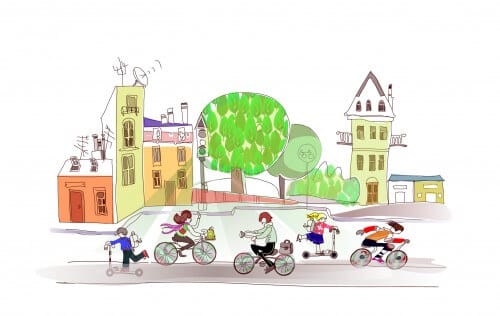In order to cultivate healthy cities, there is a need for in-depth mapping of the residents and their needs, which teaches, among other things, about health disparities between new immigrants and old residents and between Jews and Arabs.

"A healthy city" is a value and organizational worldview. A healthy city is a city in which the local authority is committed to the quality of life of all residents, and which has governmental transparency, responsibility, mutual respect and quality management.
The idea of a healthy city first came up in Canada in 1984 and was later tried and consolidated in Europe out of a desire to test the implementation of the principles of the "Health for All" convention through strategies for promoting health at the local level. Soon the local project was a global movement. The concept of health promotion is defined as a process that allows people to increase control over the factors that affect health through healthy public policies, creating a supportive environment, strengthening community involvement, developing personal skills and changing the emphasis in the health system.
In 1992, the United Nations formulated a plan for sustainable development based on principles of social and environmental justice such as responsible use of natural resources and environmental protection. This plan was adopted by the Healthy Cities movement in 1998. Israel joined the European movement under the leadership of the World Health Organization and in 1990 established an Israeli network of healthy cities, a joint initiative of the Ministry of Health and the local government center. Jerusalem, Tel Aviv, Netanya and Ramat Hasharon were the first cities to take part in the establishment of the network, which now includes more than 40 cities, local authorities and districts as well as many government offices and organizations. The network is run as a unit in the local government center and is mostly funded by the Ministry of Health.
Each authority that joins the network undertakes to adopt the principles and strategies for the development of health and sustainability so that this generation and future generations can enjoy better health and quality of life. The authority undertakes to act to improve the factors that affect the residents' health, such as environmental, educational, and social factors. and to act in partnership with all sectors of society and with the residents. This joint work makes it possible to make informed decisions, based on information and taking into account the health consequences for the various layers of the population and the resources of future generations.
A professional team of the network assists the local authorities in building the "Urban Health Profile", which describes the health status of the population at all levels, the socio-economic and environmental characteristics of the city, the social and health disparities, the wishes of the residents and the services and programs in the city and their use. The information was collected from publications of the Central Bureau of Statistics, from the records of the municipality and the medical institutions in the city and from a sample survey of residents conducted face to face. The urban profile was submitted to the local authority, the mayor and the municipal steering committee and serves as a basis for planning.
The information collected so far shows social and health disparities between cities and within them, between geographic areas and between population groups.
For example, when comparing new immigrants with veterans or natives of the country, a similar picture is obtained between the different cities. The proportion of those with 13 years of schooling or more is relatively high among the new immigrants, as well as a high proportion of them living in rented apartments, meeting less with family members and the older ones feeling more lonely. The percentage of those who rate their health as good or very good is relatively low among the new immigrants compared to the veterans and natives of the country, in all age groups. In mixed cities it was possible to compare the health habits of the Jewish population compared to the Arab population. The rate of those engaged in physical activity during their free time is double in the Jewish population compared to the Arab population, as well as the awareness of the connection between physical activity and health.
Such municipal information is action-oriented and enables the local authority to act in an informed way to promote health and reduce the gaps with the help of its many partners. The professional staff of the Healthy Cities Network accompanies the process of building the profile, learning the findings and drawing the conclusions for implementation.
For further reading, visit the website of Healthy Cities Network in Israel
on the notebooks
Milka Donhin is a doctor, an expert in public health, the head of the health promotion program at the School of Public Health of the Hebrew University of Hadassah and the chair of the Healthy Cities Network in Israel. Formerly, director of the employee health unit at Hadassah Ein Kerem.
Bracha Reger is Professor Emeritus of Microbiology and Immunology at the Faculty of Health Sciences at Ben Gurion University, President of Ort Israel and Chairman of Ort Israel's Academic Council. Served as the chief scientist of the Ministry of Health and was a member of the Council for Higher Education.
The article was published with the permission of Scientific American Israel

2 תגובות
In addition to all of Prof. Bracha Reger's glorious record, she also knows a little about city management, as she is the widow of the late Yitzhak Reger, who was mayor of Beer Sheva until his death in 1997.
I saw that the city where I live, Haifa, joined the "Healthy Cities in Israel" network. The height of cynicism! Please read the Ministry of Health document that talks about the dangers to residents due to contamination (Chapter 2) http://www.phc.org.il/wp-content/uploads/2014/07/%D7%94%D7%9E%D7%97%D7%A7%D7%A8-%D7%94%D7%9E%D7%9C%D7%90-%D7%A1%D7%95%D7%92%D7%99%D7%95%D7%AA-%D7%A1%D7%91%D7%99%D7%91%D7%AA%D7%99%D7%95%D7%AA-%D7%95%D7%AA%D7%9B%D7%A0%D7%95%D7%A0%D7%99%D7%95%D7%AA-%D7%91%D7%9E%D7%A4%D7%A8%D7%A5-%D7%97%D7%99%D7%A4%D7%94-%D7%AA%D7%9B%D7%A0%D7%99%D7%AA-%D7%9E%D7%AA%D7%97%D7%9D-%D7%91%D7%96%D7%9F-%D7%95%D7%AA%D7%9B%D7%A0%D7%99%D7%AA-%D7%A7%D7%A8%D7%A7%D7%A2%D7%95%D7%AA-%D7%94%D7%A6%D7%A4%D7%95%D7%9F.pdf The mayor pushes for polluting plans and in the "spirit of the commander" they destroy all the green lungs of the city